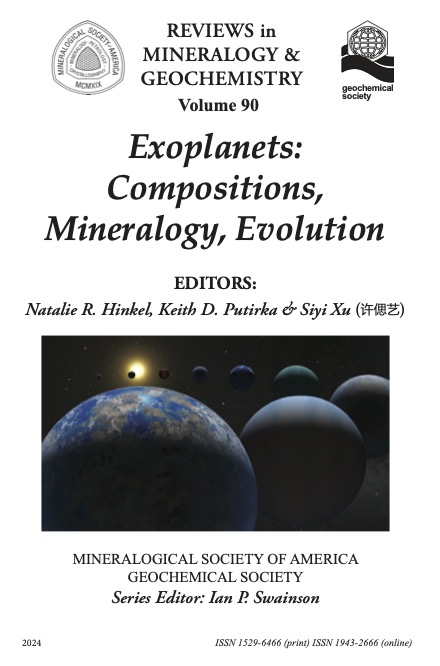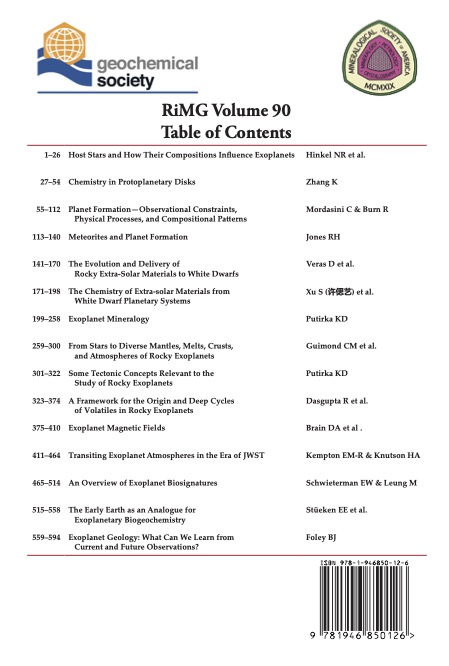Natalie R. Hinkel, Keith D. Putirka & Siyi Xu (许偲艺), editors
2024, i-xvii + 594 pages. ISSN 1529-6466


2024, i-xvii + 594 pages. ISSN 1529-6466
Description
From the Preface to the volume:
We initiated this volume with the conviction that a better union of geologic insights with astronomical ideas and data would provide the clearest prospect for increasing our understanding of exoplanets and their evolution. We realized that close communication is key. Geologists, for example, can help refine testable hypotheses that would usefully influence the astronomical targets and measurements being made by current and upcoming telescopes. The focus for this RiMG volume is on rocky exoplanets because the search for truly Earth-like planets is of special interest. Our goal is to motivate communication between the disciplines so as to make the best use possible of existing data and data yet to be collected by the James Webb and the Nancy Grace Roman Space Telescopes, since the astronomy community is gathering data on stars and exoplanets at an accelerating rate. Such data now include exoplanet size and mass (i.e., density) as well as their atmospheric compositions, which are collectively telltale of mineralogy and evolution. Much of what is published may still fall in the realm of educated speculation, but our conjectures are metamorphosing into testable hypotheses. Another intriguing turn in the Astro-Geology connection is how the telescope must sometimes be turned back towards Earth, as our speculation on the exoplanets necessarily contends with incomplete knowledge of the origin and evolution of Earth and its planetary neighbors. We hope to share expertise that will our understanding of exoplanets to develop in pace with data collection.
We begin with chapters on exoplanet host stars (Hinkel et al.), and the compositions of proto-planetary disks (Zhang et al.). The properties and composition of host stars have been crucial to examining the range of possible exoplanet compositions that might exist in our part of the Milky Way; the following chapter on protoplanetary disks gives further constraints on the compositions of the materials from which rocky planets ultimately precipitate. This begins a conversation about how and why planets can differ in composition from the stars they orbit. The next chapters also have important implications for exoplanet compositions as they cover the physics of planetary formation (Mordasini and Burn), where location and timing of planetary accretion can affect the final product, and meteorites formed in our Solar system (Jones), which provide the clearest record we have of the earliest of planetary accretion processes. The next two chapters are on so-called “polluted white dwarfs”—their compositions (Xu et al.) and the physics of how white dwarf atmospheres become polluted (Veras et al.). The “polluted” varieties of white dwarfs normally have their otherwise pure H or He atmospheres polluted by the ingress of rocky planetary materials and so these very special stars may give us our most accurate estimates of exoplanet bulk compositions.
Read more in the Preface
The Science Organizing Committee:
Natalie R. Hinkel (Louisiana State University, Baton Rouge, LA)
Keith D. Putirka (California State University, Fresno, CA)
Siyi Xu (许偲艺) (Gemini Observatory/NOIRLab, HI)
Table of Contents
Title Page
p. i Download (67 KB) 
Copyright
p. ii Download (53 KB) 





Title
p. iii Download (33 KB) 





Preface
p. iv Download (98 KB) 





Table of Contents
p. vi-xvi Download (35.1 MB) 





Chapter 1. Host Stars and How Their Compositions Influence Exoplanets
Natalie R. Hinkel, Allison Youngblood, Melinda Soares-Furtado, p. 1-26.
Chapter 2. Chemistry in Protoplanetary Disks
Ke Zhang, p. 27-54
Chapter 3. Planet Formation—Observational Constraints, Physical Processes, and Compositional Patterns
Christoph Mordasini, Remo Burn, p. 55-112
Chapter 4. Meteorites and Planet Formation
Rhian H. Jones, p. 113-140
Chapter 5. The Evolution and Delivery of Rocky Extra-Solar Materials to White Dwarfs/em>
Dimitri Veras, Alexander J. Mustill, Amy Bonsor, p. 141-170
Chapter 6. The Chemistry of Extra-solar Materials from White Dwarf Planetary Systems
Siyi Xu (许偲艺), Laura K. Rogers, Simon Blouin, p. 171-198
Chapter 7. Exoplanet Mineralogy
Keith D. Putirka, p. 199-258
Supplemental 1: 7_EXOPLANETS_PUTIRKA_supp1.xlsx
Supplemental 2: 7_EXOPLANETS_PUTIRKA_supp2.xlsx
Chapter 8. From Stars to Diverse Mantles, Melts, Crusts, and Atmospheres of Rocky Exoplanets
Claire Marie Guimond, Haiyang Wang, Fabian Seidler, Paolo Sossi, Aprajit Mahajan, Oliver Shorttle, p. 259-300
Chapter 9. Some Tectonic Concepts Relevant to the Study of Rocky Exoplanets
Keith D. Putirka, p. 301-322
Chapter 10. A Framework for the Origin and Deep Cycles of Volatiles in Rocky Exoplanets
Rajdeep Dasgupta, Debjeet Pathak, Maxime Maurice, 323-374
Chapter 11. Exoplanet Magnetic Fields
David A. Brain, Melodie M. Kao, Joseph G. O’Rourke, p. 375-410
Chapter 12. Transiting Exoplanet Atmospheres in the Era of JWST
Eliza M.-R. Kempton, Heather A. Knutson, p. 411-464
Chapter 13. TAn Overview of Exoplanet Biosignatures
Edward W. Schwieterman, Michaela Leung, p. 465-514
Chapter 14. The Early Earth as an Analogue for Exoplanetary Biogeochemistry
Eva E. Stüeken, Stephanie L. Olson, Eli Moore, Bradford J. Foley, p. 515-558
Chapter 15. Exoplanet Geology: What Can We Learn from Current and Future Observations?
Bradford J. Foley, p. 559-594